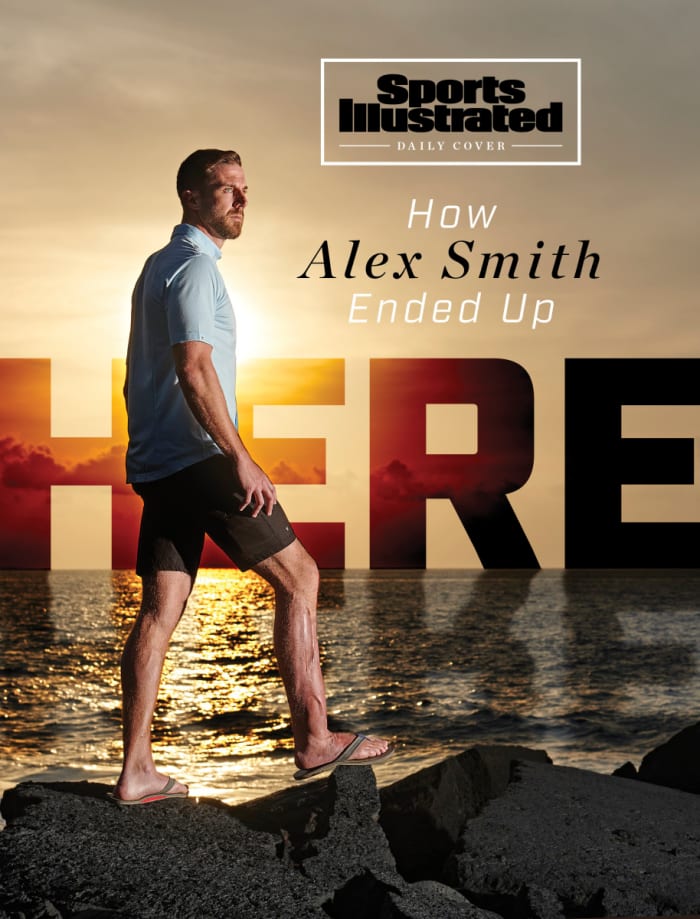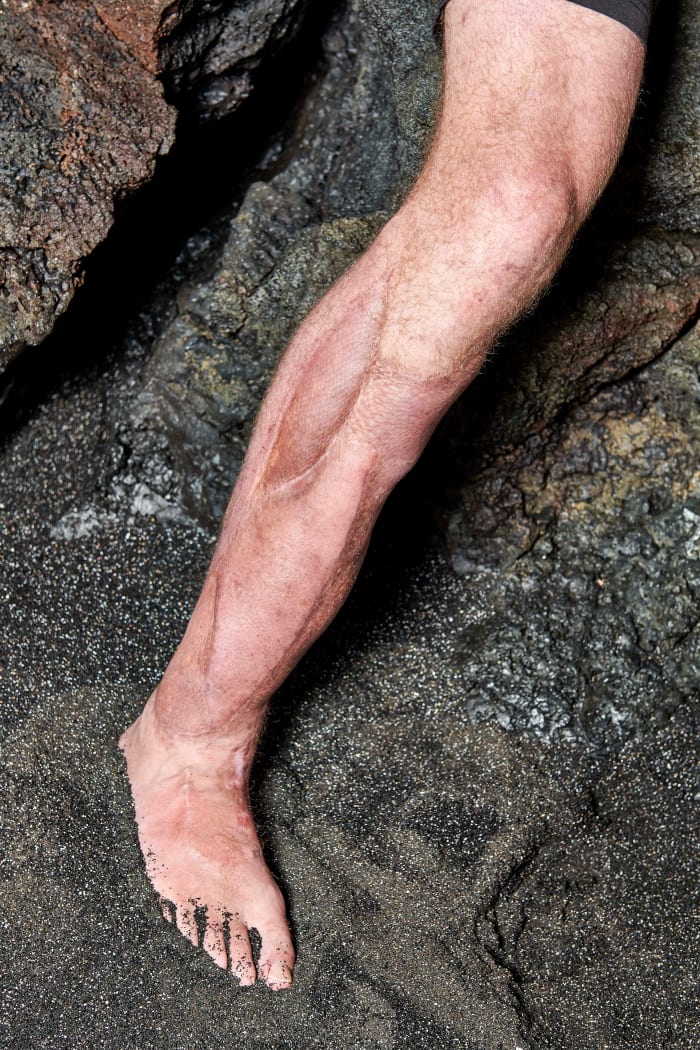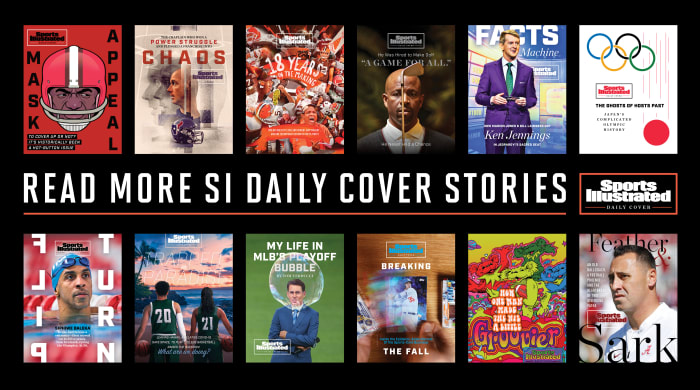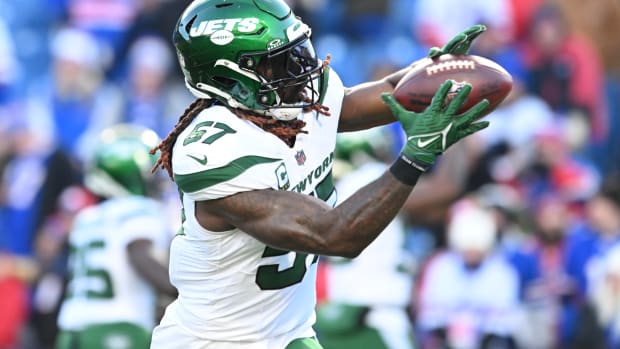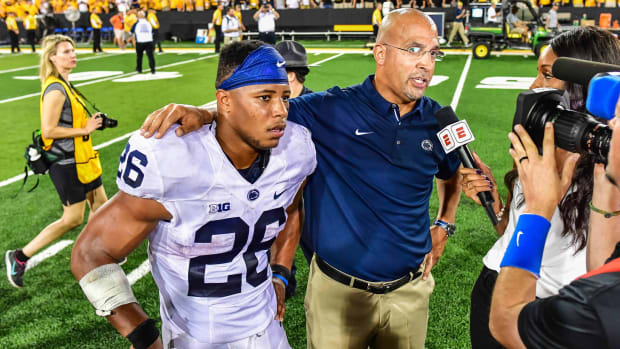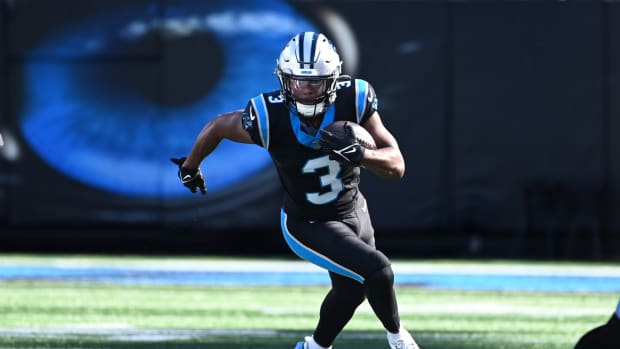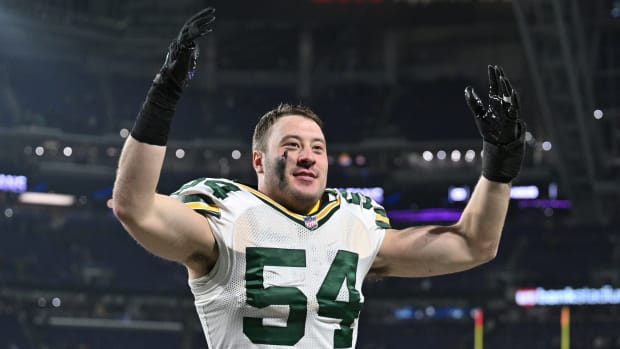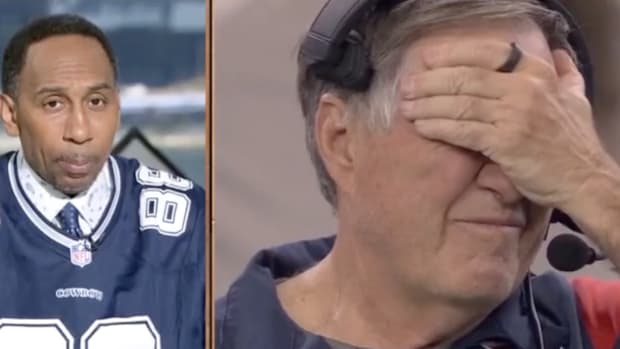Alex Smith could stand right there forever, toes spoiled by the plush strip of emerald green underfoot at his Hawaiian hideaway. “Some of the best grass in the world,” he says, awestruck, like he’s walking on cashmere covered in talc. His eyes scan the tropical paradise spread before him, all paddleboards, putting greens and palm trees, waves crashing into white sand and black lava rocks on a March afternoon so perfect that “blissful” undersells.
He orders a beef-and-rice bowl at the oceanside restaurant in this private enclave that features not one but two golf courses. A thatched roof hangs overhead, covering a table near the pond stocked with exotic fish. The waitress says something about honey and beekeepers. I can’t follow her or the soothing ocean tunes playing from the speakers overhead. I’m not scanning, because I can’t stop staring at Smith’s uncovered right leg, the one that snapped and shattered on a football field 28 months earlier.
The limb is a medical miracle, a combination of body parts stitched together, bolted in place. It’s darker than the rest of his body, shaded red, no longer straight and covered in scars that look like a baseball’s stitching. Chunks of flesh and tendon, with veins protruding from kneecap to ankle; they’re stacked like Jenga blocks, offering a confusing reminder that Smith, now 36, actually, willingly, played professional football while balancing on a body part that’s badass, bionic and horrific all at once. I confess that I can’t square the image and the inspirational story behind its existence. Don’t worry, he says.
Smith pulls the appendage closer and starts to explain the reconstruction, starting with the skin graft. Surgeons peeled squares of flesh from other places on his body, then ran them through a machine called a mesher to combine the pieces and stretch them. “Comes out like gym shorts,” he says, as I fight the urge to cringe. Before applying the graft, they also turned around what remained of his right calf (about half), wrapping it around exposed bone. Then they took a chunk of his left quad—“this guy,” he says, motioning—and added that to his right leg for heft.
Anatomy lesson complete, bugs swarming the leftovers, there’s only one question on earth that anyone would ask: Say what? Smith laughs, knowing that most see his leg as a window into his soul. Some find it sad, the damage, all he lost. Others see an NFL Rudy, his comeback among the greatest in the history of sports. Still others project their understandable apprehension, wondering, reasonably, why he’d ever want to take another snap on the same field where the force of impact pushed bone through skin. They always ask the same thing: Why? And not just last season, his final year in Washington, but as he weighs another return.
“Why come back? Because I can.”
At this moment, he says, right arm resting on that mangled leg, he wants to play football again. He knows that’s not entirely true. He also knows, deep down, that he wants it to end on his terms.
The Why People, Smith says, ask the wrong question. They don’t understand. He frames his story not by the worst day of his life but by everything before and after and how it all connects. The moment that should define him does not and would not, even when he announced his retirement on Monday. And how he got there, both back to football and comfortable enough to step away, is the story not of one comeback but of a life of them.
The Alex Smith comeback story can unspool like a fairy tale. It’s not. The warm-and-fuzzy narrative wrapped around his 2020 season ignored the tension that consumed him, that started when he returned to practice after 21 months, dozens of surgeries and numerous infections—only to discover that the Washington Football Team didn't quite know what to make of his return. He understood the hesitance, same as he recognized his own anxiety.
The franchise had overhauled its coaching staff that spring, hiring Ron Rivera and his preferred assistants, none of whom had invested in Smith, whom the WFT acquired in a trade two years earlier. They couldn’t have been expected to understand the rationale of the military rehab specialists, the only people on earth who knew that even a severe injury like Smith’s not only could be overcome but already had been. Sometimes, Smith saw his coaches flinch when they spied the blood that dripped from underneath his brace. He told friends he would not complain if they released him, told him he wasn’t good enough, or deemed him too much of a risk.
Still, he did not understand the tactics his coaches used to keep him sidelined. First, they placed him on the Physically Unable to Perform list, even though world-renowned doctors had pronounced him physically able to perform. At camp, players wore GPS trackers, and none traversed 4,000 yards a day on average like Smith, whose coaches asked him to carry extra weight, push sleds and hurdle bags for drills—tasks he had never done in 15 pro seasons, let alone before his leg had to be rebuilt. Smith believed the team wanted to see if it could break him, and if that sounds paranoid, the team physician agreed with him. They seemed to be asking, Dr. Robin West says, “What can he withstand?”
“Are you sure you’re clearing him?” the coaches would ask. West would try and explain. The short answer: Yes. The disclaimer: She would assess his leg based on her informed medical opinion. “I got very little support,” she says. “He almost died. He almost lost his leg. Why would he want to?” Reasonable questions. “That’s not your decision,” West told them.
Smith found the coaches “patronizing,” meaning he believed they preferred a cute story, the comeback already at the end. His father, Doug, says he believes the team “sabotaged” the return. None of the Smiths could figure out why. The coaches could worry about the injury and his future, but they were not experts. “I’d rather have somebody right in my face say, What are you thinking?” Smith says. “It pissed me off.”
(Rivera, as part of a statement to SI provided by a team spokesperson, says: “I was scared to death about putting [Alex] back out there and that is something I struggled with every day. It’s unfortunate that he feels we patronized him because I can tell you that was not our intention. At the end of the day, I commend Alex because he proved everyone wrong and exceeded any reasonable expectations that anyone had set for him. He not only made it back onto the field but led us to the playoffs. It was a truly remarkable feat.”)
Smith was supposed to be grateful—of course, he was grateful—and far more than they could understand. But it wasn’t enough to simply get back, run around, throw a few passes. He wanted more, and his desire spoke less to the worst day of his life and more to the rest of them. His wants were existential, and they stemmed from a career that almost ended long before 2018. At that point, on the eve of a season his own team did not want him to play, Smith resolved to prove the world wrong again. If he didn’t at least try, he says, “I don’t see how I could exist.”
Go f---ing show them, his wife, Liz, said.
On this March morning, Smith wakes up with the sunrise on The Big Island in Kona, Hawaii. His vacation home overlooks two golf greens, the ocean looming, the front yard palm-treed, the pool infinite, the hammocks beckoning for naps. Smith works out, eats breakfast and piles his three children into two golf carts, then rolls down to the beach. He returns only to take photos for his clothing line while a photographer snaps away and an assistant presses T-shirts, from his Attitude Is Free brand, emblazoned with Smith’s motto. Just Live. But how? Maybe like this, he had decided.
The years before the leg break pointed him toward that specific adage, the sequence of events—one scholarship offer, decorated career at Utah and his first-overall selection in 2005 by San Francisco—more illuminating in hindsight. Only 20, Smith landed in the worst incubator: the 49ers roster bereft of talent; the franchise steeped in a rich quarterback history, swelling expectations; a series of head coaches who specialized in defense; seven coordinators in his first seven seasons; mounting losses; a broken shoulder. Anxiety threatened to overwhelm him for the first time in his life.
Back then, the importance of mental health in sports was rarely addressed and poorly understood. Smith felt unprepared for games, and the lack of readiness only exacerbated his anxiety, and the higher stress led to on-field mistakes and the sleepless nights that followed them. At points, agonizing over unattainable external validation, Smith says he considered whether he wanted to play football anymore. Being the top pick had come to “haunt” and “paralyze” him. He realized that, soon, the choice to play football might not be his.
Smith’s worst loss, the one that made football defeats tiny in comparison, came when his best friend David died by suicide. David was 24, same as Smith, and had just taken his LSAT exam in preparation for law school. Smith didn’t know anyone smarter. Or funnier. The two had lived together, as David became the friend Smith most often confided in. But during training camp before the ’08 season, in the middle of a quarterback competition, fighting for a job he didn’t really like, Smith missed “a few phone calls” from his buddy. Another friend relayed the horrible news. All these years later, Smith says, “there’s a ton of regret.”
The on-field low point came in 2010, on Sunday Night Football, against the Eagles. The Candlestick Park crowd booed loudly after he committed three turnovers, then started chanting for his backup. His coach screamed at him, cameras capturing their sideline confrontation. Liz, a Bay Area native, started blocking childhood friends on social media. Anyone who used that four-letter word: bust.
Rather than retire, Smith focused on his mindset. His third head coach in San Fran, Jim Harbaugh, taught him to ignore outside perceptions, saving his career. His new coach in Kansas City, Andy Reid, harnessed his potential upon Smith’s arrival in 2013. In both places, a quarterback who would figure prominently in NFL history replaced him, and Smith gave to Colin Kaepernick and Patrick Mahomes what no one had given him: a mentor. Sometimes, he marveled at Mahomes’s support system—“so functional and healthy,” he says. On Thursdays, Smith would host the quarterbacks for dinner, ordering brisket from Q39 or burnt ends from Joe’s. “It finally hit me,” he says. “This isn’t going to last forever. Might as well enjoy it.”
Still, it sucked. There’s no truthful way around that. Kaepernick would start for the Niners in Super Bowl XLVII—and lose a game Doug Smith believes Alex should have won. The Chiefs would win LIV, after Alex departed, ending a half-century title drought. Liz would compare that sequence of events, so many historic in nature, to her husband playing slots for hours, taking a bathroom break and watching someone else immediately hit the jackpot from that just-vacated seat. “Honestly,” she says, “most people wouldn’t be able to handle it.”
That her husband did handle everything en route to Washington would become even more important than anyone could realize. “He had a lot of scabs torn off moving through his career,” Doug says. “But each time, he figured something out.” Something important.
How to heal.
Smith rises from that lunch in March, his leg scarred over but his less-visible scars still healing. He’s back on that down-pillow grass, where a couple of kids toss a football back and forth.
“Hey, Alex,” their father says, having overheard the conversation. “Can you throw one?”
Smith grabs the ball, spins it and zips a spiral. The offering skips short across the grass, and Smith jokes, “Bad pass; delete it.” He calls for the ball again and this time steps into the throw, which the boy grabs with his fingertips. The small crowd cheers. Smith grins, the picture of a man who loves a comeback.
The last one started on Nov. 18, 2018, when Washington hosted Houston in a midseason game heavy with playoff implications. Joe Theismann—Washington legend, Super Bowl champion and unfortunate claimant of the most graphic injury in NFL history—settled into a suite. The limp he walks with served as a reminder of the final play of his career, the one from the 1985 season against the Giants, when his right leg “snapped like a breadstick.” Two decades passed before he could bring himself to watch the replay.
Theismann had welcomed Smith that offseason, after Washington traded for him with K.C., offering a four-year extension worth up to $94 million. They laughed sometimes about the 35-ish quarterbacks who started between them.
Liz and the kids, Doug, Alex’s mom, Pam, and his three siblings huddled together in the stands that day. Kevin O’Connell, Smith’s position coach, studied the field from the sideline, along with West, the team physician. All saw Texans safety Kareem Jackson sack Smith in the third quarter, the sequence a sudden, visceral and gruesome reminder of the violence inherent in pro football.
O’Connell heard a crack; he would only later realize the sound was bones snapping. Smith rolled over, noticing that one had broken through his skin. His lower leg bent at an angle below the kneecap, in a place that legs should never bend.
Theismann knew the severity when his own leg twitched, exactly 33 years after his injury, which took place in the same city, for the same team, with the same leg, on the same field, in a similarly close game. Theismann even had a nephew named Alex Smith who was born the same year as the quarterback now crumpled on the field. As Theismann watched the replays, he turned to his wife and whispered, “It’s exactly like mine.”

It was immediately clear that Smith had suffered a major injury, but no one could know what would follow.
Simon Bruty/Sports Illustrated
Liz rushed down to the sideline and reported back to Doug, who remembers snippets of their conversation, phrases like “compound fracture” and “broken fibula and tibia.” A cart arrived. Medics lifted Smith atop it and sped toward the idling ambulance in the tunnel. As Liz rode with her husband to the hospital, he didn’t want any reassurances. He wanted to know the score of the game and how the offense had played in his absence.
Theismann knew the rehabilitation that lay ahead, the nightmares, the complications, the lifelong physical impact, not to mention the psychological one. His right knee still aches, along with his hip and his lower back, and he walks on the outside part of his right foot—all due to the injury, at least in part. His right leg is three and a half inches shorter than his left one. That day, as Smith barreled toward the hospital, the man who best understood his predicament started to pray.
Neither knew that the redefinition had already started. Smith would come to see that day not as the end of anything but as a beginning of, well, everything else. Patients who live through injuries that catastrophic in nature often pick an Alive Day, like a birthday, only to commemorate not dying. Smith chose Nov. 18.
Back at the vacation house, Smith’s oldest, nine-year-old Hudson, needs aloe for a sunburn. His middle child, Hayes (eight), wants chips. Sloane, five, tells a knock-knock joke about bananas. Amid the typical chaos, dad is hangry, mom says, ready for the shoot to end, to throw Jack Johnson on the stereo and transport back onto island time, the break he needs more than he lets on. “You probably think this is how I live,” Smith, now the model, says. He’s not yet able to admit he’s also considering an entirely new life, one so scary and unfamiliar that only Liz knows some of what he thinks he believes deep down.
Even in paradise, she can close her eyes and remember that first hospital room. She can still taste the salt from her tears. She can still smell her husband’s leg—not an antiseptic scent, but more primal, like blood mixed with rotting flesh, the odor so distinct that she pumped lavender or citrus essential oils through a diffuser to make the around-the-clock hours bearable.
Doctors had rushed Alex into surgery in Virginia, where a team of orthopedic trauma surgeons used three metal plates and 28 screws and pins to hold the leg together. They also soon discovered an infection, the result, West theorizes, of when football turf met open wound. “We realized that it’s not just any infection,” she says. “It’s necrotizing fasciitis,”—flesh-eating bacteria.
Smith’s blood pressure dropped. His fever elevated. His body reacted to both by developing stage-two sepsis, triggering inflammation that can damage organs and lead to death. Liz and Doug were forced to consider amputation, wanting Alex to live, walk, play with his children.
“Just get rid of it,” Liz told the doctors.
“Do anything you can to save it,” the patient later told them.
He underwent eight operations in the first 10 days, as doctors removed muscle and tissue to confront a series of infections. They fitted the limb with a medieval contraption known as an external fixator, which they bolted over and to his leg to hold the bones in place.
Alex remembers little from those initial weeks, his memory dimmed by the anesthesia, days lost in a surgery-to-surgery haze. But one meeting, above all others, is burned into his memory. One minute, he’s hearing the first operation went well, and that he should be discharged soon. The next, he’s in and out of consciousness, and when he’s awake, he can see the growing alarm not just from his family but from his doctors. His next “distinct memory” is coming to and seeing the trauma team, his dad and Liz. Twelve days had vanished, poof. “We’re at a crossroads,” one doctor told him. “We can cut the leg off, and that’s probably easier, and you can go on with the rest of your life. Or there’s limb salvage, which has no guarantees.”
As tears fell, Smith apologized for his emotions—they weren’t for him. “I’m crying because every person in this room has worked tirelessly just to get me to where I am,” he said.
For the month he spent laid-up there, a curtain separated him from the truth he could not face, hiding the damage. On the side he could not see, his skin darkened, turning black, fluids coloring white sheets. Liz emphasized how “cool” the scar would be, along with what progress she could highlight. Smith stared at the curtain for weeks, unable to pull it back. When he did, finally, he turned away. He wanted to vomit. “I wasn’t ready for what I saw,” he admits. “Grotesque. Deformed.”
At home, Liz helped him wheel, shower and use the bathroom—tasks she never expected to perform when he asked a mutual friend for her number 14 years earlier. She clung to better memories while she unwrapped bandages, wiped away blood and cleaned the fixator so her husband, a germaphobe, could inch back toward normalcy. She plunged needles into his arm, administering 15 different medications, everything from blood-thinner shots to antibiotics. She hired companies to make their house accessible with ramps and shower handles and rented a van large enough for their new wheelchair. She taught Hudson to help his father move around so she could leave them alone together. “This is what you do for people you love,” she told all three kids.
Ultimately, the family chose limb salvage, starting the comeback to save his leg. Dad posed at home before that Christmas under their tree. He flashed a thumbs up to the camera. But a blanket still covered his lower half.
Afternoon turns to evening in Hawaii, as Smith settles onto a kitchen stool and expresses gratitude for the team that did believe in him. The pivot point: Feb. 2019, when he traveled to San Antonio, bound for the Center for the Intrepid (CFI), a military rehabilitation facility. There he would meet two people who would change his life and force the most optimistic colonel in military history to wrangle a high-level security clearance for a pro athlete to do something no pro athlete had ever done.
As plane approached runway, Smith admits he held tightly onto the bitterness that threatened to devour him. He loved football, had always loved football, would always love football. But he hated it right then, for the bones that snapped, the wheelchair he sat in and the leg that he might lose.
First, he sat down with Kelly Elmlinger, a Paralympic athlete who conveyed necessary and uncomfortable truths. Rehabilitation would be unending and uneven, pocked with setbacks, fraught with mystery, the physical pain unbearable, the mental toll even worse. “That’s the thing,” she said. “It’s very personal, this process. Very intimate.” Smith caught himself staring at Elmlinger’s prosthetic leg; he still could not identify with his wounded one, “always like,” he says, “this isn’t me.”
She launched into her story: high school athlete, lifelong runner, college dropout, Army grunt, certified nurse. She jumped out of airplanes. Deployed three times. Became a medic, assigned to CFI, caring for amputees. That particular assignment called to her, even when she could not understand why. Then, fate, or something close. Doctors diagnosed her with synovial sarcoma, a rare form of soft-tissue cancer that birthed a malignant tumor in her left leg, forcing her to confront the same decision Smith now wrestled with. She chose limb salvage—and still had to amputate two years later. But Elmlinger also emphasized that CFI had returned hundreds of “Alex Smiths” to combat and right there, the football Alex Smith’s concerned expression faded. For the first time since the injury, he saw what might be possible—just as the sunny-side-up colonel, Dr. Joseph Alderete, had hoped for when he invited Smith down for that initial consult.
Smith’s defeatism melted away that trip. He stared at the limbs of other patients, legs shattered by bullets, arms blown off by bombs, and no one told him to look away. He met triple amputees. He heard from veterans thrown half a football field by explosives. All wanted to return to active duty. He gained perspective, and not the cliched kind; their injuries were worse, and they had, as Alderete says, “made successful returns to Olympic sports or kicked in doors and grabbed Bin Laden.” None hid their limbs behind curtains or blankets; they owned their story. What made them different emboldened them to be more so.
Johnny Owens, former CFI rehabilitation specialist, became the QB’s new coach that week, humbling Smith the way that football had in San Francisco. Owens started by introducing Smith to his new teammates. They rehabbed most mornings at CFI and trained again all afternoon. Initially, Smith lagged behind the veterans, a rookie trying to find his center yet again. That same trip, he fell down on a balance exercise and hung his head. “Stop with the pity party,” Owens snapped.
He threw Smith a football. Holding the very thing that made him famous, anxious, rich and immobile, the quarterback groaned inside. This stupid game. But gripping while balancing helped him stay upright longer. Owens started shoving Smith, trying to knock him askew. No luck.
The therapist backed up and motioned for Smith to throw, as cameras from E:60 captured the rarest of moments, the exact instance when NFL history changed. From his knees, the quarterback let loose a spiral, the impact so sudden and forceful it knocked Owens backward. That act, at once simple and cathartic, transported Smith back to childhood evenings spent playing catch in the backyard with his older brother and his dad. He threw another pass, then another hundred passes. “It was like [Owens] was daring me to play football again,” Smith says.
Smith started carrying a football everywhere he went, his new companion so ubiquitous that doctors had to remind the QB that his comeback chances still fell somewhere between slim and less-than slim. He knew he sounded deluded but simply floating the notion that he wanted to return produced an unexpectedly fierce emotion—relief. He still had that fixator bolted to his leg. He could hardly walk. But later that night, he sent Owens a text message: Alright, it’s frickin’ on. Just tell me what I gotta do.
Smith can’t find his phone that evening in Hawaii, as kids buzz by, paint dries and storm clouds gather on the horizon. He heads to another room, discovers his electronic appendage and returns like he’s holding a prize. When he looks down, there’s a video from Owens, the same kind of clip the therapist has forwarded for months. All feature men and women running in prosthetics or on salvaged limbs, jumping out of planes, wading into combat. Smith spends countless hours watching and re-watching them, these injections of hope he calls “crucial” to his changing mindset.
For months, he drew on the video-induced motivation, needing to break down small, achievable actions rather than the totality of the inconceivable feat ahead. He started to take metaphorical first steps rather than actual ones. In May 2019, he went to mini-camp. In June, he publicly announced his comeback plot. In September, he returned to FedEx Field for the first time since his bones snapped.
He also came to learn what Elmlinger meant by uneven recovery. Smith could not simply will himself toward success the way he had in football. Imaging scans bolstered unwarranted optimism. He started walking again. Doctors shortened the fixator, permitted golf and weightlifting and greenlit a family vacation to Hawaii. But on the second day of the trip he desperately needed, Smith’s pain morphed into a version so extreme he went to the hospital.
One fracture in his leg had not actually healed. A “non-union,” the surgeons called it. “This is never going to end,” Smith lamented, consumed by then with doubt.
He tried hiding his worst fears. In December, he dismissed the notion that he would settle into more of a front-office/inspirational/mentor role. Soldiers, he reasoned but not publicly, didn’t make it back to war to sit behind a desk. Alderete, the CFI surgeon, sometimes watched Smith attack the treadmill, despite a condition (drop foot) that made it difficult to lift the front part of his right shoe. Therapists would increase the resistance and elevation and Smith would just march faster, flashing a thumbs up.
Therapists fitted Smith with something called an IDEO Brace, the name long and jargon-y but the purpose clear. For most of military history, this technology simply did not exist, meaning veteran Alex Smiths were almost always forced to amputate. The IDEO changed that. Designers fashioned its frame from lightweight black carbon fiber and arranged a foot plate that could fit inside a shoe, attaching the frame to the plate with a strut that ran up the back of the calf, standing in for the calf muscle that typically atrophied. The contraption worked like a spring, as force on the plate bent the strut, creating energy that transferred forward with each step. Smith would not have been able to attempt his return without it.
As weeks passed and his progress gained momentum, Smith became an amateur physical therapist. Since his leg had withered during recovery, he used a custom tourniquet that Owens rigged up to a computer to measure blood flow and boost bone density while Smith knocked out leg lifts. It felt like working out with a boa constrictor attached to the limb. Liz tried the torture chamber once. “I’d rather give birth,” she says.
She tried to introduce moments of levity when possible. Like transforming the fixator into a replica of the Lombardi Trophy and turning the injury into family Halloween costumes, her husband the shark attack victim, her kids the baby sharks. This helped her temporarily ignore what Alex wanted.
He wiggled deeper down this limb salvage rabbit hole, becoming a poor man’s braceologist as well. He read scientific journals and scoured Amazon late at night for new models. He bought like 50 iterations that varied in size, stiffness and flexibility. He wore different ones for walking, running and golf. He couldn’t find one for football, because a model didn’t exist. But he did stumble across Michael Porter Jr., the NBA forward with the same condition. Porter’s team sent over the designs and, after nine rounds of adjustments, Smith had not only the will to return to football but the equipment he needed, too. He named that brace “No. 9.”
It worked better than intended. Smith missed only a few practices last season, though he watched most from the sidelines, buried third on the QB depth chart. The cancellation of OTAs due to COVID-19 meant even fewer reps than usual could be dispersed. Alderete would counsel Smith to remember what actually mattered, telling him he could play free, after surviving far worse for far too long. “All the other s--- gets thrown in the wastebasket, and do what you were put on earth to do,” the doctor said.
Dinner tonight in Hawaii is a buffet of pizza, sushi and salad on the table out back by the pool. Smith cracks open a beer, leans back in his chair. But rather than stare at the ocean, he’s reminded of another meeting, on another deck, that made possible his comeback—his then and now colliding yet again.
Last July, the Smiths sat down with a huddle’s worth of doctors to determine his football fate. It seemed like 20 years had passed in 20 months. Smith tempered his expectations, prepared to weigh differing opinions. But as the group assembled like old friends gathering for a barbecue, the same doctors who spent months operating and reminding Smith of how delicate he was were now telling him they had reached a consensus.
“You can if you want,” West said.
“Are you sure?” Smith asked.
Heads around the table nodded. Liz fully aligned with the comeback supporters after listening to the doctors on that deck. She had needed those months to close the gap between their contrasting desires. That night, she stood firmly behind him—so firmly that Alex admits he’s not sure if he would have been that selfless if the situation were reversed. “It wouldn’t be fair if I stood in his way, because I’m supposed to be his support system,” she says. “I didn’t want him to have regret.”
The docs did tell Alex that they would not return, if they were making the decision that only he could make. But on Aug. 16, 2020, the quarterback’s new team cleared him to return to his old one. His family doused him with celebratory champagne as Liz joked, “You better not get cut.”
She can hardly believe what happened next. No one can. Alex made the roster, as a third-stringer. But as Washington prepped for the Rams in Week 5, coaches sent starting quarterback Dwayne Haskins home to recover from a stomach virus. Rivera named Kyle Allen the starter, which meant that Smith could celebrate his ascension to a role he had never coveted before: backup. No one was ever happier to spend a week imitating Jared Goff on the scout team.
Smith woke up early every day, grabbed coffee and listened to NPR on his drive into work. The “other s---" had been thrown in the wastebasket; he was an actual NFL quarterback again, right down to the butterflies. On game day, he went for a walk. Called Liz. Stretched. Nothing special, and that was the special part.
When it came time to address his teammates, Smith told them to stay in the present, forget their anxiety. Just live. He might as well have been talking to himself.

Smith made his first start since the injury at Detroit last November, leading a 21-point second half comeback that nearly forced overtime.
Raj Mehta/USA TODAY Sports
He expected clipboard duty that afternoon, but even then, he knew as well as anyone how much one play could change lives, seasons, franchises. He saw Allen crumple to that FedEx Field turf in the second quarter. This time, instead of riding off the field, Smith jogged onto it for his first real snap in 693 days. He wore brace No. 9 and noticed both benches empty, everyone heading to the sideline, a stadium holding its collective breath. “I felt alive,” he says.
Less-than-ideal conditions greeted him. Like the Rams’ NFL-leading defense, with stars in Aaron Donald and Jalen Ramsey. And the weather, cold and rainy. Plus, the abbreviated warm-up. Owens, the therapist who coaxed Smith back toward football, started to feel trepidation. “Oh, s---, Alex,” he thought. “Don’t break.”
Next: a standing ovation, from both teams, given in an empty stadium; masks stained with more tears; coast-to-coast concern over his return; and a doctor, at a military hospital in Baghdad, after another long day in the trauma ward. Rockets pounded the base nearby. Alderete walked outside and screamed like a caveman. “Take that!”
Three plays into the greatest comeback in NFL history, Donald climbed onto Smith’s back, all 284 extra pounds now supported, in part, by that reconstructed leg. “Like Alex was giving him a piggyback,” Liz says.
The Rams won easily. In the aftermath, as Liz tried to organize another celebration, her husband obsessed over the weather, missed throws, sacks taken. Just returning wasn’t enough. It never would have been.
For so long, he couldn’t consider football. Now, he couldn’t consider anything else. He began to dream about this season rather than just the last one. “Alex may not say this, but I think he didn’t want them,” Liz says, meaning the coaches, “to have their I-told-you-so moment.” Meaning he didn’t want them to believe that they were right, that he should not have played, nor have come back. She poured champagne at home while Alex studied his tablet and muttered things like “the second half was a mess.” At one point, he realized: He hadn’t thought about the limb since he ran onto the field. At that point, she realized: This had never been about bringing the cute comeback story to completion.
“I guarantee, in his mind, he’s not done,” Theismann said in March. He understood the longing. After his career ended and he segued into broadcasting, Theismann would jump into drills with whatever team he happened to be covering, wishing for one more play. His partners would tease him, telling him to let go. “I can’t,” he’d respond. “It’s part of me.” When people said similar things about Smith’s comeback, he’d tell them, “You just don’t understand who we are. Being on the field is as much a part of us as one our limbs.”
The fairy tale continued teetering, just like Smith’s longer story arc, the perfect imperfect match. X-rays would reveal a late-season stress fracture in that right leg. His doctors would term this injury “unrelated” to the previous one. Coaches deemed it a calf strain—implaying, Smith thought, that it was related. They placed Smith on injured reserve for the playoffs, a Wild-Card loss to Tampa Bay, when there’s no doubt in his mind that he should have suited up.
He wasn’t sure he wanted to play another season, but if he did, he knew it wouldn’t be in Washington. West, the team doctor, also resigned after 18 years in the NFL. Smith says, “I can’t help but wonder, God, did I start that?”
This spring, Smith took a family vacation to Big Sky, Mont. He wanted to snowboard again. For a long time, particularly at the end of last season, he believed that notion espoused by Theismann. That he needed to complete his football return the way he wanted, not with some unwelcomed cameo tinged by bad weather and stress. But Smith’s mindset shifted, again, the night before his first run, when the “healthy terror” descended, and he couldn’t sleep due to anticipation. “The fear gets closer,” he says. “It’s right there, getting off the chairlift. Is my leg alright?”
He sailed down the mountain, over and over, pausing occasionally to take in the view with three generations of Smiths, the beautiful expanse below as wide and inspiring as his life since that Alive Day. He couldn’t shake the feeling, how he harnessed the anxiety and tempered the panic. “I put this off for 17 years for football,” Alex told his dad. He started to realize something else with his arms draped around his sons: He could fulfill the desires fueling the comeback without risking injury, putting his fate in the hands of skeptics, or spending most of the year obsessed. There were other mountains. They were safer, too.
“I think I’m ready,” he told Liz. “I think I’m done.”
For a few more weeks, he was willing to listen to offers. Jacksonville called, proposing a chance for poetic symmetry. Smith could reunite with his college coach, Urban Meyer, and mentor the presumed next No. 1 pick in Trevor Lawrence. But the team’s orthopedic surgeon came back after the physical and pointed out the “non-union” that remained in his leg. It still had not fully healed. They called Alderete together, right then, and the optimistic colonel told the Jags that Smith was the only non-union athlete he had ever cleared and why. Still, Jacksonville offered a contract, though Jags GM Trent Baalke wanted Smith to sign a special waiver for his leg and suggested any team would request the same. The Texans wanted him too, but their quarterback situation remains in flux. Smith also heard from the Patriots, Eagles and Colts. But everyone had questions, conditions. He realized that only one path remained to leave football on his terms.
All those months searching for a perfect football ending had borne an unexpected discovery: He already had one. Everyone from Theismann to West said the comeback player of the year award should be named after Alex Smith.
The Smiths flew to Virginia last week to celebrate not with the Washington Football Team but with their trauma one. They rented a party bus and took all the doctors, surgeons and rehab specialists out to dinner. “You saved my life,” Smith told them. Then they all went axe throwing. The quarterback could still sling it. But the wife of one trauma surgeon won the tournament.
More proof: time to move on. And, soon, move in. In August, the Smiths will complete their dream home in the Bay Area. After years of delays and adjustments—both construction and football—instead of moving somewhere else temporarily for another season, they will settle into their permanent base, non-tropical version. There’s symmetry there, too.
On Monday, the morning Smith announced that he would retire from pro football, he first went to couples’ Pilates class. He and Liz laughed about one story in particular.
Near the end of that snowboard trip, the Smith boys piled onto the biggest chair lift at a ski slope in North America. When they reached the top of another mountain, they were supposed to settle onto a moving walkway, the winter version of an escalator. Smith, his legs attached to his snowboard, tried shifting on the magic carpet, only to fall and not be able to rise. His boys laughed and his brother tried to lift him. The walkway operator, unaware of the comeback king in front of him, said simply, “Dude, get up.”
He did.
More SI Daily Covers:
• Trevor Lawrence Is Out to Prove Absolutely Nothing
• The Year of the Opt-Out Prospect
• The Tao of Whit: Andrew Whitworth's O-line Life
































